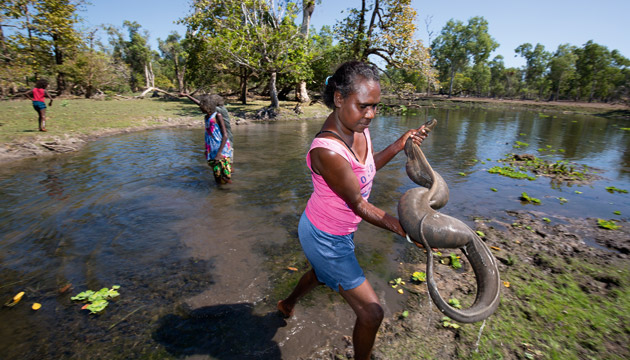Increasingly, the Arafura Swamp is becoming a major source of income for Yolngu people through tourism, fire management and the gathering of crocodile eggs.
Story + Photos David Hancock
Mary Dhapalany and Evonne Munuygu plunge knee-deep into the dark waters of Gatji billabong in the Arafura Swamp of Arnhem Land to search for file snakes, a much-loved food of Top End Indigenous people. Despite the waterway being home to scores of saltwater crocodiles, the two sisters of actor David Gulpilil explore the shallow reaches and shoreline, thrusting their arms and hands deep into the water among pandanus roots and floating logs.
File snakes have loose, rough skin and grow up to 2.5 metres long. Yolngu people who live close to the Arafura Swamp know the aquatic species as djaykung and have collected them for millennia. The snakes were traditionally killed by a hunter biting down on their head, but today they are usually hit with a rock before being thrown on a fire.
More than 15 Aboriginal clans live around the huge swamp, 500 kilometres east of Darwin, which they know as Gurruwiling. It is the largest paperbark swamp in Australia. Fed by the Goyder and Gulbuwangay rivers, it covers an area of 700 square kilometres in the dry season between May and November and spreads to engulf up to 1300sq km in the wet.
The area is a complex mosaic of plant communities dominated by large numbers of paperbark trees. The most striking of all the plants is the Arafura palm that grows up to 20m in height. After a life of about 70 years, the palm’s final effort is to produce an enormous branching stem that carries thousands of plump, red seeds.
Gurruwiling was formed about 6000 years ago in a large shallow basin on the floodplains. It is fed by underground springs and the wet season run-off from the Arnhem Land plateau. The swamp is home to diverse and rare species, and has deep cultural significance for the Yolngu people, who have occupied and managed the area for thousands of years.
Plants and animals of the swamp are important sources of food and medicine and, even though many Yolngu currently live in communities at Ramingining and Milingimbi, with stores that sell western commodities, they rely on bush tucker to supplement their diets and maintain good health. Many refer to Gurruwiling as their “supermarket”.
This story excerpt is from Issue #122
Outback Magazine: December/January 2019









